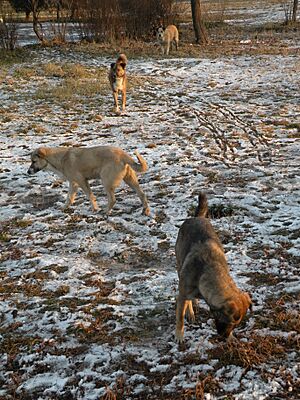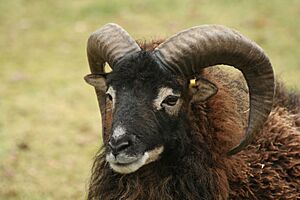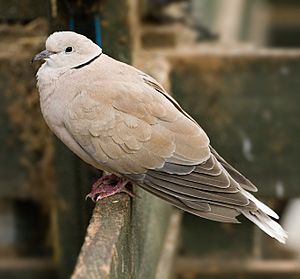Feral facts for kids
A feral organism is a plant or animal that has changed from being tame or cultivated to living wild. Think of it like a pet that decides to live on its own in nature!
A feral animal is one that has escaped from being a pet or from a farm and now lives mostly like a wild animal. Animals that were already wild before they escaped, like a lion from a zoo, are not called feral. Some common examples of animals that become feral are goats, cats, and pigs.
Domesticated plants that go back to living wild are usually called escaped, introduced, or naturalized. But the changes they go through are similar to those of animals.
Some species become feral easily and do well in the wild. Other species usually don't survive well on their own.
When feral animals or plants are introduced to new areas, they can sometimes harm the local ecosystems. In some cases, they have even caused native species to become extinct. However, sometimes feral species can help control other problem species, like rodents or harmful insects.
Contents
What are some feral animals?

Dogs can easily become feral animals and become successful hunters.
The cat can also easily become feral. Feral cats are often seen as pests in both cities and rural areas. They have caused serious harm to bird, reptile, and mammal populations. Since feral cats breed quickly, it's hard to control how many there are. In some places, a method called "Trap-Neuter-Return" is used to manage their numbers.
The goat is one of the oldest domesticated animals. Yet, it easily becomes feral and does quite well on its own in the wild.
Dromedary camels, which have been tamed for over 3,000 years, also readily become feral. Feral camels in Australia are descendants of pack animals that escaped in the 1800s and 1900s. They are now thriving in the Australian outback.
Sheep are usually vulnerable to predators and injuries, so they don't often survive as feral animals. However, in places with few predators, like with the Soay sheep, they can do well.
Water buffalo are found in the wetter parts of Western and Northern Australia. The Australian government encourages hunting feral water buffalo because there are so many of them.
Cattle have been domesticated for a very long time, but they can survive for months or even years without much human care. Their ancestors, the Aurochs, were quite fierce. Modern cattle, especially those raised on open land, are generally calmer. But they can become aggressive if they feel threatened. Cattle, especially those raised for beef, are often allowed to roam freely. They have become independent in Australia, New Zealand, and some Pacific Islands. There are also small groups of semi-feral cattle in the southwestern United States and northern Mexico. These cattle are sometimes called "Mavericks" or "Scrubbers."
Horses and donkeys, tamed around 5000 BCE, are found living wild in grasslands worldwide (see feral horse). In Portugal, feral horses are called Sorraia. In Australia, they are called Brumbies. In the American west, they are called Mustangs. Other isolated feral groups exist, like the Chincoteague Pony and the Banker Horse. These are often called "wild horses," but this isn't quite right. Truly "wild" horses have never been tamed, like Przewalski's Horse. In Australia and the Americas, modern "wild" horses came from domesticated horses brought by European explorers and settlers that escaped and thrived.
The pig has feral populations all over the world, including Australia, New Zealand, the United States, New Guinea, and the Pacific Islands. Pigs were brought to these regions by humans long ago. Many European wild boar populations also come from escaped domestic pigs.
Rock Pigeons were once kept for their meat or as racing animals. They have now formed feral populations in cities worldwide.
Colonies of honey bees often escape into the wild. Their behavior is similar to bees kept by humans, unless they breed with other feral bees. This can make them more docile (calm) or more aggressive.
Large populations of feral parrots are found in different parts of the world. The Rose-ringed Parakeets, Monk Parakeets, and Red-masked Parakeets are very successful outside their native homes. They adapt well to suburban areas.
How feral organisms affect the environment and economy

Ecological impact of feral organisms
A feral population can harm an ecosystem by eating plants or animals that are already vulnerable. They can also compete with native species for food and space. Feral plants and animals are often invasive species. This means they can be a threat to endangered species.
Genetic mixing with wild animals
Domestic animals can sometimes breed with native, wild animals. This mixing of genes can threaten the existence of the original wild population. Examples include the mallard duck, wild boar, the rock dove (pigeon), and salmon. Another example is the dingo, which is an early feral dog itself. It can breed with other dogs.
Economic harm from feral animals
Feral animals compete for food with farm animals. They can also damage fences, water sources, and plants by overgrazing or spreading seeds of invasive plants. For example, feral horses compete with cattle in the western United States. Goats can also damage trees and plants in dry regions of Africa. Feral animals can also pass on diseases to farm animals.
Economic benefits of feral animals
Many feral animals can sometimes be caught easily and cheaply. This makes them an important economic resource. In many parts of Polynesia and Melanesia, feral pigs are a main source of animal protein. In Australia, feral goat, pig, and camel meat is exported. Sometimes, animals were purposely left to become feral on islands. This was so they could be caught later for food or profit, especially for sailors.
Scientific value of feral populations
Scientists can study populations of feral animals. This helps them learn about how populations grow, how they interact with their environment (ecology), and their behavior (ethology) when living wild. This information can be very useful for farmers.
Genetic diversity in feral animals
Feral populations sometimes have special characteristics that are not found in fully domesticated animals. This helps keep domestic biodiversity strong. These unique traits often deserve to be protected, either in their wild environment or as domestic animals.
Cultural or historic value
American Mustangs have been protected since 1971. This is partly because of their connection to the history and romantic idea of the American West.
Related pages
Images for kids
-
Alfalfa plants, Medicago sativa, growing by roadsides
-
A feral goat in Cornwall
-
An escaped cow walks down a street in Namie, Fukushima, a town evacuated after the 2011 Tōhoku earthquake and tsunami. When people leave an area, their pets or farm animals can become feral.
-
Feral donkeys
-
Rock doves, also known as pigeons: feral animals that live close to humans
-
A family of feral chickens, Key West, Florida
See also
 In Spanish: Cimarrón para niños
In Spanish: Cimarrón para niños














